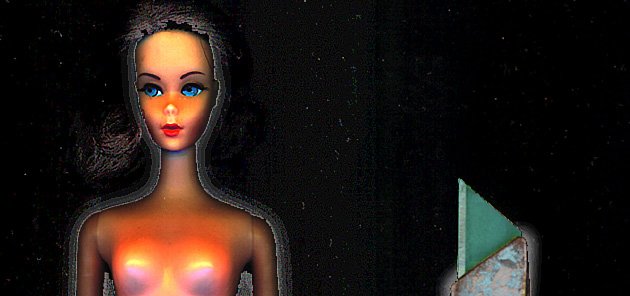
In 1987 I painted my first Barbie. I had been painting mostly abstractions, and decided I wanted to do realistic work for a change. I needed a subject that would be a challenge to render accurately; with enough details and nuances to keep me busy for awhile. And it had to be something that anyone would immediately recognize, so I would know if I had made a convincing portrait or not. I took a trip to my parent's house (always a good place to find oddball objects), and started to snoop around. In the attic I came across a pair of Barbies, vintage models from the 60's. Something clicked (snapped?). I took them home with me. They presented a fair challenge: subtle coloration, complex volumes, exact proportions, symmetry, and that patented vacuous Barbie expression. Now I needed an object to contrast the Barbie, something very un-Barbie that would liven up the painting, and create a visual dialogue in the composition. Looking around my studio, I spotted a utility knife, the short round handled Stanley variety often used to cut cardboard. The bluish grey metal of the Stanley made an interesting contrast with the pinkish, plastic, long legged shape of the Barbie. Or so it seemed at the time. Call me a closet psycho (many do), but I never saw this as a violent image. It was about visual effect and the craft of painting. But once I started to paint the images I realized they had another impact. There was a meaning lurking around these two objects. Just by putting them close to one another a sinister suspense emerged. Reactions to the painting were harsh. Everyone saw the painting as if it told a violent story. Odd, because the objects were in completely static positions. There was not a hint of action in the painting. And the colors were subdued too. Yet the images that people saw in it were quite gruesome. More intriguing, most viewers saw the Barbie as a woman, not as a doll. Although they knew this was the image of a doll, they projected the idea of an actual female into the Barbie, added murderous intent, and found themselves looking into a horrific scene. They could not separate the symbol from the symbolized. And they could not recognize that they were interpreting the images. Instead they attributed these horrific images they saw to me, as if I had painted a murder scene, not a still life. I'm not saying I was completely innocent. I knew the painting was pushing people's buttons. But the buttons were already there, part of the individual's experiences. I didn't put them there. I just called attention to them. I experimented further and found that Barbie is quite a loaded symbol. Put a Barbie next to just about anything and meaning will rear its ugly head. This little pink lady is just too well known, and way to voluptuous to be perceived as just an object. She leaps into our psyches and roams freely in our subconscious, along with mom, the mother superior and the Virgin Mary (yes, I was raised Catholic). And so began my Barbie awareness program.
back to The Distorted Barbie
contact napier@interport.net
|